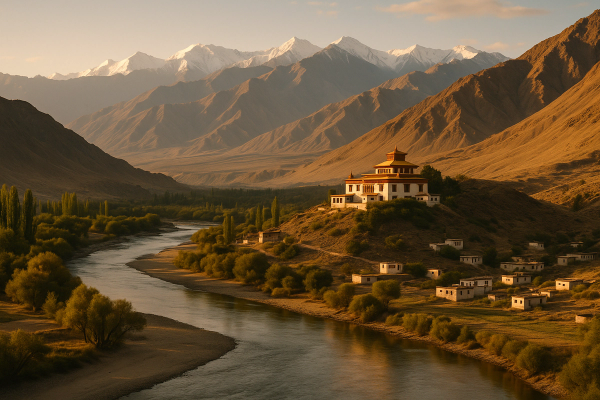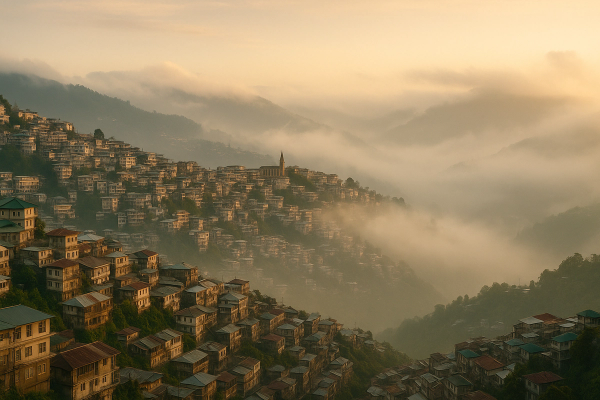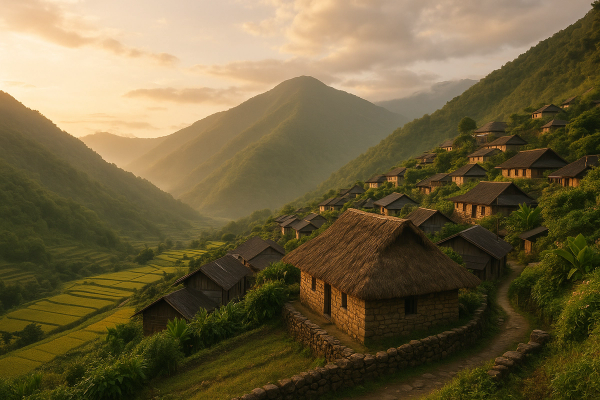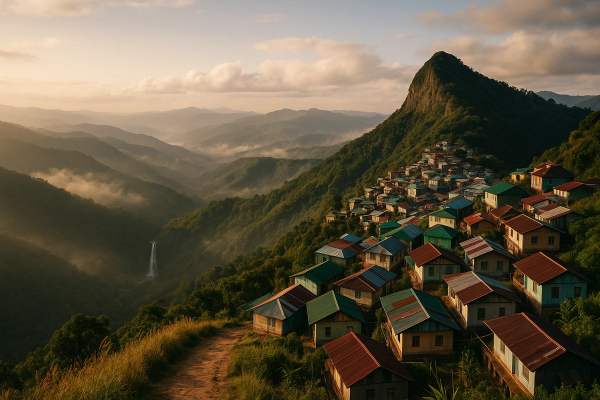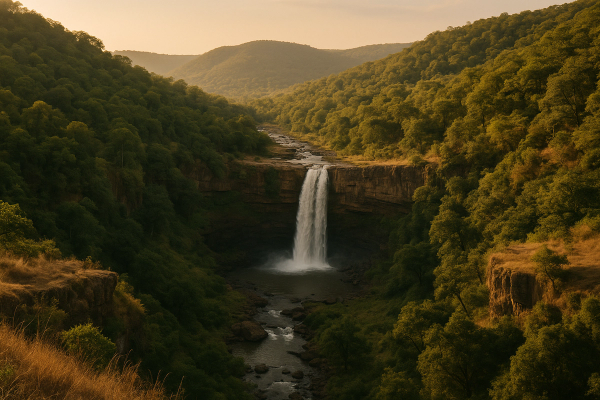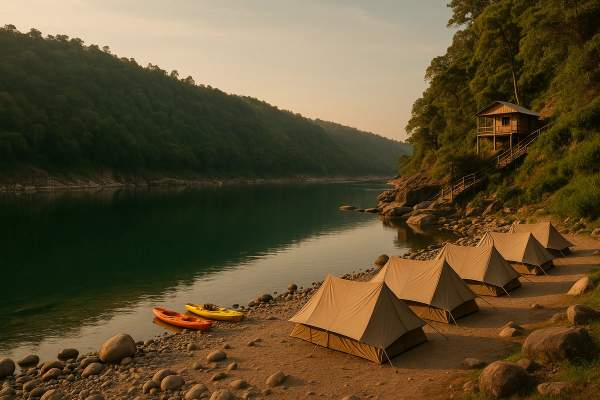Okay, Let's Talk Yellowstone: Geysers, Bison Jams, and Why It's Awesome#
So, Yellowstone. You've heard of it, right? America's first national park, land of Old Faithful, traffic jams caused by giant fluffy bison... yeah, that place. I finally made the trek out there last year, kinda on a whim after seeing way too many cool wildlife photos online. And honestly? It completely blew my expectations out of the water. It's huge, it's wild, it smells faintly of sulfur sometimes (lol), and it's just... epic. If you're thinking about hitting up some national parks USA, Yellowstone needs to be high on your list. This isn't gonna be some super formal Yellowstone travel guide, more like me spilling everything I learned – the good, the slightly chaotic, and the absolutely unforgettable. We'll cover the must-see Yellowstone attractions, how to maybe spot a bear (from a safe distance, obvi), and just general tips for navigating this massive park. Ready? Let's dive in.¶
What's the Big Deal About Yellowstone Anyway?#
Alright, quick overview. Yellowstone is MASSIVE. Like, bigger-than-Rhode-Island-and-Delaware-combined massive. It spills across Wyoming, Montana, and Idaho. It sits on top of a supervolcano (don't worry, it's chill... mostly), which is why you get all the crazy geothermal stuff – geysers, hot springs, bubbling mudpots. It's legit like another planet in some spots. Established way back in 1872, it set the whole idea for national parks rolling worldwide. So yeah, it's kinda historically significant. Plus, it's one of the best places for nature travel in the US, especially if you're into wildlife. Think bison herds, elk chilling by the road, maybe even bears or wolves if you're lucky (and careful!).¶
When Should You Actually Go?#
Okay, timing is kinda key 'cause Yellowstone changes A LOT with the seasons. Most people go in summer, but lemme break it down.¶
Summer (June-August): Peak Season Madness#
This is when everyone goes. Weather's generally warm and sunny (usually!), all roads and facilities are open. But man, the crowds. Parking lots fill up super early, lines can be long, and finding lodging last minute is basically impossible. Accommodation prices are highest.¶
- Pro: Best weather, everything's accessible.
- Con: SO. MANY. PEOPLE. Seriously, Old Faithful feels like Times Square sometimes. Also, bugs can be intense.
Shoulder Seasons (April-May & September-October): The Sweet Spot?#
I went in early September and honestly, it felt pretty good. Fewer crowds than summer, though still busy. Fall colors start popping in late September/October which is gorgeous. Spring means baby animals (!!) but also unpredictable weather – snow is totally possible, even in May, and some roads might still be closed.¶
- Pro: Fewer people, potential for fall colors or baby animals, slightly lower prices maybe.
- Con: Weather is a gamble (pack layers!), some facilities might have limited hours or be closed.
Winter (November-March): A Whole Different World#
Okay, I haven't done winter yet, but it sounds magical. Snow-covered landscapes, steaming geysers in the cold air... wow. But access is super limited. Most roads are closed to cars, you gotta rely on snowcoaches or snowmobiles for tours. It's quiet, peaceful, and totally unique.¶
- Pro: Almost no crowds, stunning scenery, unique experience.
- Con: Very limited access, extremely cold, requires special transport/tours.
My take? Early fall (September) felt like a good balance. Still decent weather, slightly fewer crowds than July/August. But honestly, any time you can go is better than not going!
Getting There and Navigating the Beast#
Yellowstone isn't exactly next door to a major city, so getting there takes a bit of planning. You'll most likely fly into a regional airport and then drive.¶
Flying In#
Your main options are:¶
- Bozeman Yellowstone International Airport (BZN) in Montana: Often the busiest and might have more flight options. About 1.5-2 hours drive to the North or West entrance.
- Jackson Hole Airport (JAC) in Wyoming: Right near Grand Teton National Park (bonus trip!). Closer to the South entrance, stunning views flying in.
- Yellowstone Airport (WYS) in West Yellowstone, MT: Only open seasonally (like June-Sept) and has fewer flights, but it's right at the West entrance.
- Cody Yellowstone Regional Airport (COD) in Wyoming: Good access to the East entrance.
- Idaho Falls Regional Airport (IDA) in Idaho: Another option, bit further drive to the West entrance.
No matter where you fly, you absolutely need to rent a car. Seriously, the park is enormous, there's no real public transport inside the park to get you between major sites.¶
Driving Around Inside#
Yellowstone has two main loop roads: the Upper Loop and the Lower Loop, forming a figure-8. It takes way longer to drive than you think. Why? Lower speed limits (45 mph max, often slower), winding roads, and... wildlife jams!¶
Real talk: A bison deciding to take a nap in the middle of the road will happen. Just chill, enjoy the view (from your car!), and wait. It's part of the Yellowstone experience. Do NOT get out of your car near bison.
Cell service is basically non-existent in most of the park. Download offline maps (Google Maps offline feature is your friend) or grab a paper map at the entrance. Also, fill up your gas tank whenever you see a station (they're sparse).¶
Where to Crash: Lodges, Campgrounds, and Gateway Towns#
Okay, sleeping arrangements. You've got options, but the biggest tip? BOOK EARLY. Like, a year in advance if you want to stay inside the park, especially for the iconic lodges. Seriously.¶
Inside the Park: Lodges & Cabins#
Staying inside the park is awesome for early morning access and just soaking it all in. Managed by Xanterra Parks & Resorts.¶
- Old Faithful Inn: The iconic one. Rustic, historic, amazing lobby. Books up FAST.
- Lake Yellowstone Hotel: Grand, historic hotel on the lake. More elegant vibes.
- Mammoth Hot Springs Hotel: Near the North entrance, recently renovated.
- Other lodges/cabins: Canyon Lodge, Grant Village, Lake Lodge, Roosevelt Lodge. Variety of styles and price points (but none are truly 'budget').
Inside the Park: Camping#
Yellowstone has numerous campgrounds, some reservable, some first-come, first-served (FCFS). Reservable sites also book up months in advance. FCFS requires arriving very early, especially in summer.¶
Heads up: Camping here means being bear-aware. Strict food storage rules are in place for a reason. Know the rules before you go.
Gateway Towns: More Options (and Amenities)#
Staying outside the park entrance gates can be cheaper and offer more amenities (restaurants, grocery stores). But it means driving in and out each day, which adds time.¶
- West Yellowstone, MT: Busiest gateway town, lots of hotels, restaurants, IMAX theatre. Right at the West entrance.
- Gardiner, MT: At the North entrance (the only one open year-round to cars). Smaller, more rustic feel.
- Cody, WY: East entrance gateway. Real cowboy town vibe, Buffalo Bill Center.
- Jackson, WY: South entrance gateway. More upscale, near Grand Teton NP.
The Main Event: What You Absolutely Gotta See & Do#
Alright, the fun stuff! There are SO many Yellowstone attractions, you could spend weeks here. But here are the non-negotiables and some personal faves.¶
Geyser Gazing: Steamy Wonders#
- Upper Geyser Basin (Old Faithful Area): Duh, you gotta see Old Faithful erupt. Check predicted eruption times at the Visitor Center. But don't just see Old Faithful! Walk the boardwalks through the whole basin – tons of other cool geysers and pools (like Morning Glory Pool, wow). Allow a few hours.
- Midway Geyser Basin (Grand Prismatic Spring): Home to that insane rainbow-colored spring, Grand Prismatic. The boardwalk gets you close, but honestly, the best view is from the Fairy Falls Overlook trail (a short, easy hike starting from the Fairy Falls parking lot just south). Totally worth the detour.
- Lower Geyser Basin (Fountain Paint Pot Trail): Less famous maybe, but super cool mudpots that go blub blub blub. It's a quick loop walk.
Geyser Tip: Always, always, always stay on the boardwalks and designated trails in thermal areas. The ground is fragile and the water is dangerously hot. Seriously.
The Grand Canyon of the Yellowstone: Jaw-Dropping Views#
Not that Grand Canyon, but still spectacular. A massive canyon carved by the Yellowstone River with two powerful waterfalls (Upper and Lower Falls).¶
- Artist Point: Classic viewpoint on the South Rim for Lower Falls. Expect crowds, but it's iconic for a reason.
- Inspiration Point & Grandview Point: North Rim views. Worth seeing both rims if you have time.
- Brink of the Lower Falls Trail: Steep trail down to see the massive waterfall up close. It's intense going back up, but powerful.
Mammoth Hot Springs: Like Another Planet#
Located near the North Entrance. These are totally different from the geyser basins – travertine terraces formed by hot water flowing over limestone. Looks like an inside-out cave. You can walk on boardwalks through the upper and lower terraces. Elk often hang out in the Mammoth village area too.¶
Wildlife Watching Heaven: Lamar Valley & Hayden Valley#
Often called 'America's Serengeti'. These wide-open valleys are prime spots for wildlife.¶
- Lamar Valley (Northeast): Best chance for bison herds (like, hundreds!), pronghorn, maybe coyotes, bears, or even wolves (especially early morning/late evening). Bring binoculars and patience!
- Hayden Valley (Central): Another great spot for bison and birds. The Yellowstone River meanders through here.
Wildlife Safety 101: Keep your distance! Recommended distances are 100 yards (a football field) from bears and wolves, and 25 yards from bison, elk, and other animals. Use binoculars or a zoom lens. Never feed wildlife.
Yellowstone Lake: Big Water#
It's huge! Largest high-elevation lake in North America. You can take boat tours, kayak, or just enjoy the views from spots like West Thumb Geyser Basin (geysers right on the lake shore!).¶
Food Situation: Fueling Your Adventures#
Okay, Yellowstone isn't exactly a culinary destination, let's be real. Food options inside the park are mostly functional – lodges have dining rooms (reservations often needed!), cafeterias, and general stores with snacks and basic groceries.¶
Eating Inside the Park#
- Lodge Dining: Can be pricey, variable quality. Old Faithful Inn Dining Room is popular (make reservations!).
- Cafeterias/Grills: Quicker, more casual options at places like Canyon Village, Old Faithful Snow Lodge.
- General Stores: Good for grabbing drinks, chips, maybe some sandwich supplies.
Pro Tip: Pack your own lunches and lots of snacks! It saves time, money, and lets you eat with an amazing view at a picnic spot whenever hunger strikes. There are picnic areas scattered throughout the park.
Eating in Gateway Towns#
You'll find way more variety and often better value in towns like West Yellowstone or Gardiner. From pizza joints to nicer restaurants.¶
Stuff You Should Know: Practical Tips#
Just a few extra things that might help your Yellowstone travel guide planning.¶
Budgeting Basics (Approximate!)#
Costs can vary wildly, but here's a rough idea:¶
| Expense | Daily Estimate (Per Person) | Notes |
|---|---|---|
| Park Entrance | $35 / vehicle / 7 days | Or buy an America the Beautiful Pass ($80/year) if visiting multiple parks |
| Lodging (In-Park) | $150 - $500+ / night | Highly variable, book WAY ahead |
| Lodging (Gateway Town) | $100 - $300+ / night | Slightly cheaper generally |
| Camping (In-Park) | $20 - $40 / night | Reservations essential |
| Food | $50 - $100+ / day | Depends heavily on packing vs. eating out |
| Gas | $$$ | Lots of driving, fill up when you can |
| Bear Spray | $40 - $50 / can | Rent or buy. Know how to use it. |
Packing Essentials#
- Layers, layers, layers: Weather changes FAST. Bring fleece, rain jacket, warm hat, gloves, even in summer.
- Good walking shoes: You'll be doing a lot of walking on boardwalks and trails.
- Sunscreen, sunglasses, hat: The sun is strong at altitude.
- Bug spray: Especially near water or in evenings.
- Binoculars: ESSENTIAL for wildlife viewing.
- Reusable water bottle: Stay hydrated! Filling stations available.
- Bear spray: Know how to use it and carry it accessibly on hikes.
- Camera & extra batteries/memory cards: Duh.
- Offline maps/Park map: Don't rely on cell service.
Packing mistake I almost made: Not bringing enough warm layers for early September mornings. It was COLD before the sun really got going!
Staying Safe & Sane#
- Wildlife: Keep distance. Store food properly. Be aware.
- Thermal Areas: Stay on boardwalks. Don't touch the water.
- Altitude: Take it easy the first day if you're coming from sea level. Drink water.
- Driving: Obey speed limits, watch for animals (especially dawn/dusk), pull over completely to view wildlife (don't stop in the road!).
- Connectivity: Prepare to be offline. Tell people your plans beforehand.
Okay, How Long Do I Need? Suggested Itineraries#
You could spend weeks, but here are ideas for shorter trips.¶
The 3-Day Whirlwind (Lower Loop Focus)#
Fast-paced, hits the big geyser basins and the canyon.¶
- Day 1: Arrive (West Yellowstone?), explore Midway Geyser Basin (Grand Prismatic overlook!), Lower Geyser Basin, check into lodging. Sunset/evening at Upper Geyser Basin (Old Faithful).
- Day 2: Morning exploring more of Upper Geyser Basin boardwalks. Drive towards Yellowstone Lake, see West Thumb Geyser Basin. Head north to Hayden Valley (wildlife watch), then explore the Grand Canyon of the Yellowstone (Artist Point, Inspiration Point).
- Day 3: Drive Norris Geyser Basin (another big one!), then maybe head north towards Mammoth briefly before exiting, OR backtrack slightly for anything missed.
The 5-Day Explorer (Both Loops)#
More relaxed pace, covers both loops.¶
- Day 1 & 2: Similar to Day 1 & 2 above, but maybe slower pace, add a short hike.
- Day 3: Focus on Grand Canyon of the Yellowstone (maybe hike partway down?), drive north towards Tower Fall area.
- Day 4: Early morning drive through Lamar Valley for wildlife! Explore Mammoth Hot Springs terraces and village.
- Day 5: Revisit a favorite spot, do a longer hike, explore Norris Geyser Basin more thoroughly before heading out.
Be a Good Visitor: Responsible Yellowstone Travel#
Yellowstone is precious, fragile, and wild. Let's keep it that way.¶
- Stay on Trails & Boardwalks: Protect fragile thermal features and vegetation.
- Respect Wildlife: Keep your distance, never feed them, store food securely.
- Leave No Trace: Pack out everything you pack in. Don't take rocks, flowers, or anything else.
- Drive Safely: Protect wildlife and other visitors.
- Reduce Waste: Use reusable water bottles, minimize single-use plastics.
It sounds simple, but seeing people get way too close to bison for a selfie is just... stressful and dangerous. Don't be that person!
Final Thoughts: Is Yellowstone Worth It?#
Um, YES. Absolutely, 100%. Despite the crowds, despite the planning needed, Yellowstone is genuinely one of the most incredible places I've ever been. Seeing a geyser shoot boiling water hundreds of feet in the air, watching a herd of bison thunder across a valley, seeing colors in a hot spring that don't even look real... it's pure magic. It's a reminder of how powerful and wild nature can be.¶
My biggest takeaway? Plan ahead, especially for lodging, but also allow for spontaneity. Some of the best moments were unplanned stops for wildlife or just sitting by a steaming river. Give yourself enough time, embrace the occasional traffic jam (bison naps!), and just soak it all in.¶
So yeah, if you're looking for an epic nature travel adventure in one of the most iconic national parks USA, start planning that Yellowstone trip! You won't regret it. Have you been? What was your favorite part? Drop a comment below! Or if you're planning a trip, hopefully this Yellowstone travel guide helped a bit! Maybe check out link text for other travel ideas? 😉¶






